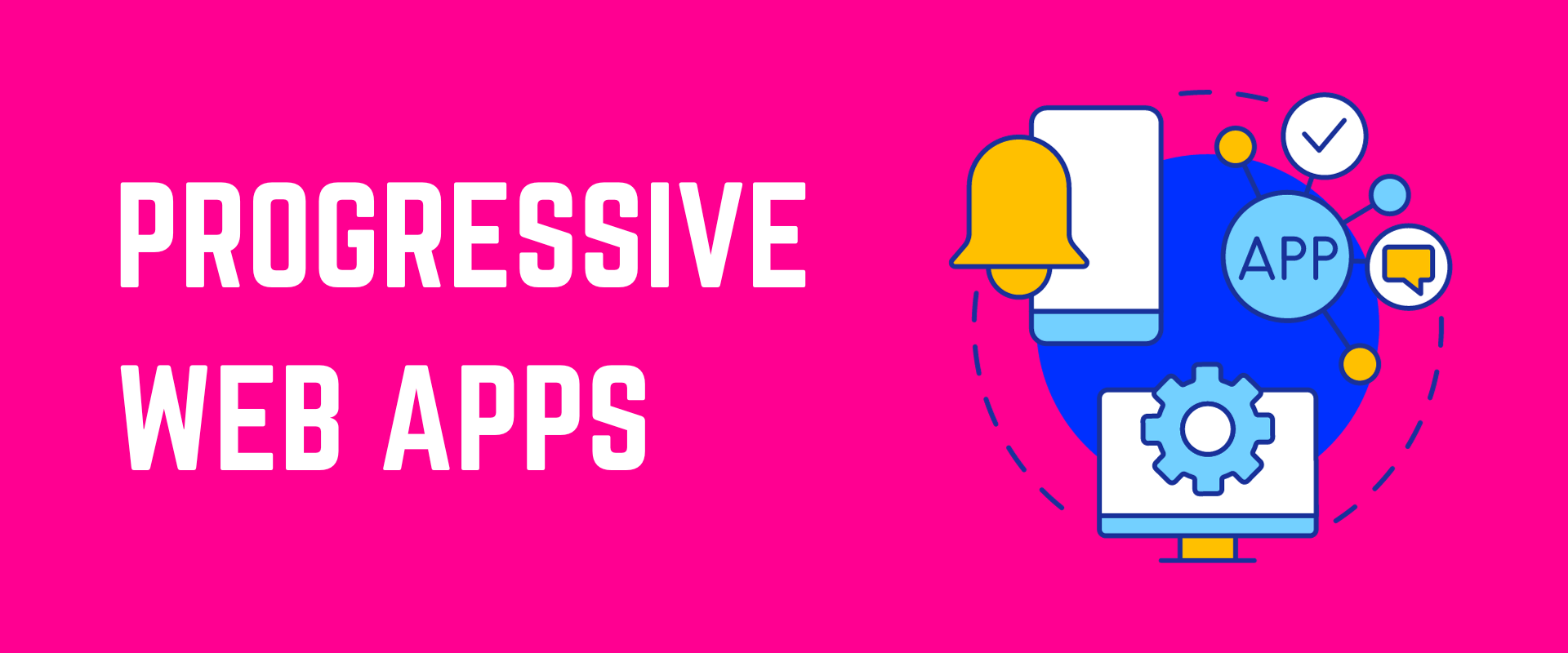
Listen to this article now:
Audiences today expect seamless, app-like experiences from websites thanks to the ease offered by mobile phones.
Enter progressive web apps, the best of both worlds - websites and native apps.
But what are PWAs, what benefits do they offer, and what are the best PWA development practices you must consider?
Let’s explore!
Table of Contents
What Are Progressive Web Apps?
Progressive web apps or PWAs are types of web apps that blend web and native mobile technologies. This innovative approach offers users an app-like experience without the need for downloading or installing an app from an app store.
The words "Progressive Web App" (PWA) were introduced by Google Chrome engineer Alex Russell.
This term refers to a new breed of web applications that load like regular websites but capitalize on features supported by modern browsers, such as service workers and web app manifests.
These features empower PWAs to provide users with functionalities like offline work, push notifications, and other capabilities typically associated only with native applications.
How Does a PWA Operate?
A PWA doesn't adhere to a specific technology, it instead represents a fresh methodology in constructing web applications, incorporating modern features, APIs, and patterns.
To be classified as a progressive app, a website must, at a fundamental level, register a service worker, utilize HTTPS, and possess a web app manifest file.
These three prerequisites enable the support of various modern features and capabilities.
Distinguishing a progressive web app from a standard web application may not be immediately evident.
The level of "progressiveness" in a web app is assessed on a spectrum, gauged by the extent to which progressive technologies and features are integrated.
Hire Professional Web Developers
CDP’s web development team excels in creating tailored progressive web apps across industries. Hire our web dev experts today!
Benefits of Progressive Web Apps
Let’s delve into some compelling benefits of progressive web apps:
Offline Functioning
A progressive web app has the ability to operate offline, eliminating the dependence on a continuous network connection.
This independence achieved through service workers and APIs that cache page requests and responses, enables seamless functionality and accessibility even in offline or unstable network conditions.
With service workers, web browsers can cache essential resources, ensuring uninterrupted access to application features even without a stable connection.
For businesses with product catalogs, a PWA offers significant promise as web browsers cache the app, enabling users to browse products offline.
This not only enhances user engagement but also has the potential to increase revenue, especially in areas with unreliable internet.

Improved SEO
A progressive app comes with a built-in advantage for online visibility as it’s designed to be Search Engine Optimized (SEO). It means PWAs are more discoverable and compatible with search engines, enhancing their presence on the internet.
To achieve this, progressive web apps adhere to specific global standards and formats, making it easier for search engines to catalog, rank, and surface their content.
For instance, a website aspiring to be a PWA must support HTTPS and include a web app manifest. These standards not only boost the application's searchability but also contribute to its overall security.
Additionally, meeting these modern technical requirements enables progressive features, such as the ability to add a website shortcut to a mobile device's Home Screen.
The SEO capabilities of PWAs can lead to a surge in traffic, making them a strategic choice for businesses aiming to enhance their online presence and reach a broader audience.
Responsive Design
As of last year, more than half of internet traffic originates from mobile devices, prompting brands to revise their user experience strategies.
In this era, where users expect a seamless journey across desktop, mobile, and physical touchpoints, responsive design has become essential.
It involves a web application's ability to automatically adjust to a device's layout and user behavior.
Progressive web apps use modern technologies to ensure the flexibility and responsiveness of their user interface.
PWAs are synonymous with responsive design, meaning they can seamlessly adapt to various devices like mobile phones, tablets, or desktop computers.
This ensures users enjoy a consistently optimized experience, regardless of their chosen device.

Enhanced Performance
Google emphasizes that 53% of users abandon a site if it takes longer than 3 seconds to load. A progressive web app tackles this by offering superior load times than standard web apps.
Progressive web apps prioritize lightweight data consumption and efficient caching, resulting in impeccable responsiveness, better loading speed, and smoother animations.
This translates into a more enjoyable, adaptable, and scalable user experience across various devices.
A PWA also stands out for its ability to employ progressive enhancement techniques, ensuring functionality across different browsers and devices, even when these browsers have varying capabilities.
This innate compatibility sets PWAs apart from standard web apps and native mobile apps.
Here are some excellent examples of PWA performance:
- Twitter observed a significant 75% increase in tweets sent and a 20% decrease in bounce rate following the launch of their PWA.
- Pinterest witnessed a remarkable 60% surge in user engagement post-launching a PWA.
- Lancôme experienced a notable 17% increase in conversions and a 53% rise in mobile sessions after introducing a PWA.
Built-In Security
Progressive web apps offer inherent security advantages as they are constructed using HTTPS, encrypting the data exchanged between the server and app.
This encryption makes it more difficult for hackers to access sensitive information.
Furthermore, PWAs depend on service workers to facilitate app functionality and mandate an app manifest that governs how an app can be launched and displayed.
In contrast to native applications, PWAs usually have more restricted permissions, lowering the risk of security threats.
The integration of these technologies collectively works to prevent potential attacks and enhance the overall security of the app.

Convenient Installation
PWAs offer a distinctive feature – they are installable on devices, setting them apart from traditional sites and apps.
This capability allows users to conveniently access the application through an app icon, creating a more streamlined and integrated user experience.
Rather than opening a web browser and typing a URL, users can simply click on the shortcut on their home screen when they want to use the application.
While progressive web apps don't necessarily require installation to function, providing this option enhances the app's performance and makes it feel more like a native application.
This, in turn, reduces friction in the re-engagement process for users.
Cost-Effective
Progressive apps can be developed using web technologies like CSS, HTML, and JavaScript, making them a cost-effective alternative to creating separate native mobile apps for each operating system (iOS, Android, etc.)
In contrast to progressive web apps, native mobile apps usually demand more time and resources for development, involve distinct specifications for each operating system, and come with app store maintenance fees.
Excellent User Engagement
A progressive web app offers abundant opportunities to elevate user engagement, with push notifications being a prime example.
Push notifications, widely recognized for their effectiveness in keeping users engaged, boosting retention, and ultimately enhancing user lifetime value (LTV), are a hallmark of native apps.
Progressive apps, in particular, utilize web push notifications to re-engage users even after they've exited a website.
This technology operates seamlessly on both desktop and mobile devices, fostering a cohesive, consistent, and engaging user experience across diverse platforms.
Moreover, PWAs also use other native capabilities, such as geolocation and access to the camera and microphone.
Best Practices for Progressive Apps
Let’s explore the best practices you must follow when developing progressive web apps:
Adapt to All Browsers & Devices
When it comes to developing a PWA, you need to ensure adaptability across various browsers and devices.
Testing your progressive web app across different browsers, employing feature detection, and embracing progressive enhancement principles enhance compatibility.
Focus on universal functionality first, using basic technology, and then enhance the experience for supported devices.
You also need to test across all types of devices, emphasizing responsive design to make content accessible on all screen sizes.
Rearrange app content for different viewports, prioritize key information, and support diverse input methods such as mouse, keyboard, touch, or stylus.
Utilizing semantic HTML elements ensures consistent support for all user input methods.
Offer Offline Capabilities
Your PWA should offer a seamless experience to its users, even in slow network or offline scenarios. A custom offline page is essential for consistency across browsers.
Create engagement with a personalized offline page using a service worker to intercept network requests. Elevate the app experience by enabling functionality when users are offline.
For instance, users can compose emails offline, and the app will save and send them automatically when online.
Fulfill user expectations of uninterrupted app usage, regardless of network conditions.
Use Deep Links
Enable support for deep links in your progressive web apps. Deep links are hyperlinks directing users to specific pages within your app's domain, enhancing user experience and discoverability.
For instance, while your app's home page may be at https://homepage.com/, deep links can navigate users to specific product pages like https://homepage.com/products/123.

Leverage the power of web technologies by embracing this feature. Offering unique URLs for different app sections enables users to bookmark, directly navigate to, and share specific content.
Moreover, search engines can index your app's content, enhancing discoverability through web searches. Deep links are a powerful tool to maximize user engagement and improve your app's visibility.
Prioritize Speed
Create a fast-loading PWA to meet user expectations. Unlike websites, users anticipate installed apps to consistently perform at high speeds.
The rapid loading and execution of core functions significantly influence user engagement and retention while slow app response leads to increased user abandonment.
Utilize tools, APIs, and best practices to measure and enhance app performance. Explore web performance for comprehensive insights.
Optimize your PWA for quick loading times by leveraging browser caching, minimizing large image usage, and implementing techniques like lazy loading for non-essential resources.
Deliver an App-Like Experience
Seamlessly integrate your progressive web app with the operating system. Users expect PWAs to behave like installed platform-specific apps.
Consider the following guidelines to achieve an app-like look and feel:
- Utilize a standalone display mode for a dedicated app window.
- Define a distinctive app icon.
- Adapt your app's theme based on the user's preferred color scheme.
- Customize theme and background colors for a polished, platform-specific feel.
- Streamline content by focusing on essential tasks, replacing traditional headers and footers with a menu metaphor.
- Optimize content with the system-ui font-family for a more platform-native feel and faster loading without additional font downloads.
Comprehensively Test Your PWA
Conduct thorough testing on different devices and browsers to ensure the proper functioning of your PWA on all platforms.
This includes testing offline functionality, compatibility with various screen resolutions, and the user experience on different operating systems.
Additionally, use secure connections via HTTPS and double-check compliance with applicable data protection regulations.

The Future of Progressive Web Apps
Progressive Web Applications are emerging as the future of user experience on mobile and desktop devices, thanks to their native-app-like experience, development ease, and accessibility.
The continuous evolution of web technologies is driving the widespread adoption of PWAs, indicating a significant rise in their popularity.
PWAs are transforming the web experience due to their emphasis on cross-platform compatibility, offline support, and optimal performance.
Adhering to these best practices becomes crucial with continued development for crafting a compelling and user-friendly progressive web app.
Elevate Your Website Today!
CDP offers comprehensive web development services. Our web developers have the industry expertise to craft custom progressive web apps for all types of businesses and agencies.
With CDP’s professional developers, you’ll get a web app that meets all your goals and offers an excellent app-like experience and user engagement.
